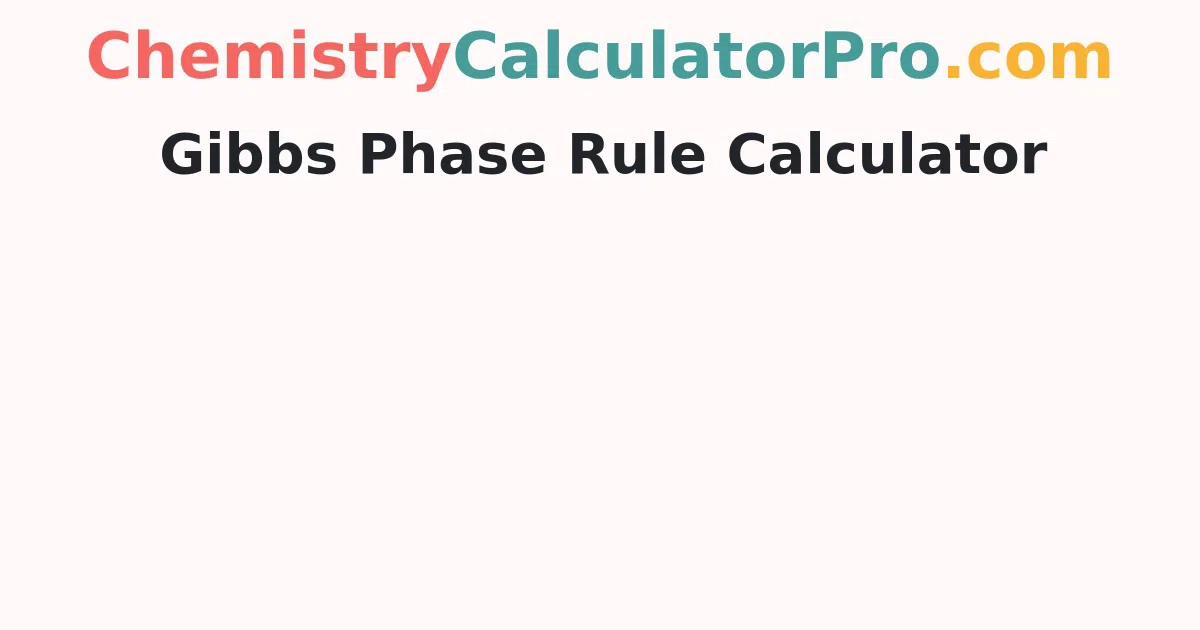Gibbs Phase Rule Calculator
Use our free Gibbs Phase Rule Calculator to quickly get the number of degrees of freedom for the phase rule. Simply input the number of components, phases, and factors in the appropriate sections, then click the calculate button to get an instant result.
What is the Gibbs Phase Rule?
Gibbs' phase rule is a theoretical principle for characterising a system's chemical state that is based on thermodynamic laws. It exists as a function of physical parameters such as pressure and temperature and predicts phase equilibrium relations. Furthermore, the phase rule allows for the creation of phase diagrams in order to depict and comprehend phase equilibriam in heterogeneous systems.
The phase rule equation, introduced by Josiah Willard Gibbs (an American theoretical physicist and Yale University professor) in 1875, is expressed as the Gibbs phase rule equation; F = C - P + factor
- Where, F = number of degrees of freedom
- C = number of components
- P = number of phases in the system
The factor is affected by the system's temperature and pressure. Given the number of components (C) and phases in the system (P), this equation can be used to calculate the number of degrees of freedom (F).
Phase Rule Details
Number of stages(P): A phase is a type of matter with chemical composition and physical properties that are consistent across its volume. In the system, it is also a physically separate material. We can find out the difference between solid, liquid, gas, plasma.
Number of Parts (C): C stands for the smallest amount of chemical components required to make up all of the system's phases. The molecule cannot be the result of a chemical reaction between other system components.
Number of Degrees of Freedom Available (F): The number of variables (e.g., temperature, pressure, component concentration) that may be altered independently (within specific limits) without changing the state of the system is referred to as F. (e.g., the numbers of compounds and phases). The number of degrees of freedom grows as the number of components grows and the number of phases in balance decreases.
Phase Rule Details
- Step 1: For calculations, select a chemical system. Assume it consists of a single component that exists in two periods.
- Step 2: Pressure and temperature can both alter in that system.
- Step 3: In the calculator, enter the appropriate numbers: the number of compounds and phases, as well as the factor, which in this case is equal to 2.
- Step 4: In the last calculator field, check the result.
FAQ’s on Gibbs Phase Rule
1. What is the best way to apply the Gibbs phase rule?
Under equilibrium conditions at constant pressure, the Gibbs phase rule p+n=c+1 gives the relationship between the number of phases p and components c in a given alloy. Where, n = number of thermodynamic degrees of freedom
2. How can you find out how many phases there are in a phase rule?
According to the phase rule, F = C - P + 2. Hence, the number of degrees of freedom for a one-component system with one phase is two, and any temperature and pressure can be achieved within limits.
3. What is the Gibbs phase rule and why is it important?
Gibbs' Phase Rule is a thermodynamics-based theoretical framework for describing the chemical state of a (geologic) system and forecasting the equilibrium relations of the phases (minerals, melts, liquids, vapours) existing as a function of physical circumstances like pressure and temperature.
4. What are the phase rule's limitations?
The following are the limits of the phase rule: It is only applicable to a single equilibrium state. It does not imply any other feasible system equilibrium. The number of phases is taken into account by the phase rule, but not their quantities.
